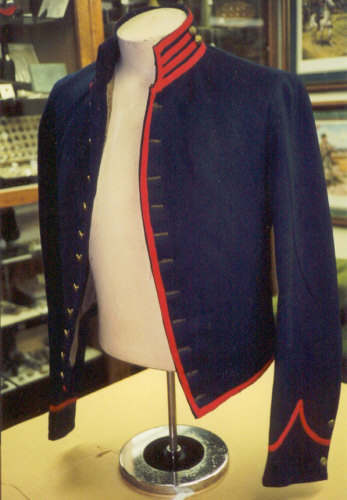 Back
ground: In December of 1998, Dave Jurgella and I
had the opportunity to inspect and document a mounted
services jacket on display at the Farnsworth House in
Gettysburg, PA. This jacket is now in a private
collection. The jacket appears to have been surplus and
never issued or worn. It is in excellent condition. If you
have a specific question regarding this jacket or the St.
Louis Depot, please contact me at:
tailor@cjdaley.com Back
ground: In December of 1998, Dave Jurgella and I
had the opportunity to inspect and document a mounted
services jacket on display at the Farnsworth House in
Gettysburg, PA. This jacket is now in a private
collection. The jacket appears to have been surplus and
never issued or worn. It is in excellent condition. If you
have a specific question regarding this jacket or the St.
Louis Depot, please contact me at:
tailor@cjdaley.com
.The St. Louis Depot Mounted Services Artillery Jacket has
many of the same features that you would find on a
contract-made mounted services jacket.
However,
this garment is not a contract-made item, but rather a
government-produced item. While it has the standard
six-piece body and two-piece sleeve construction seen on
most mounted services jackets, it also has many features
that can be considered anomalies.
The St.
Louis Depot may have begun production as early as the
1830's to support the dragoon units on the western
frontier. Complete Adjutant Generals Reports are
unavailable, however 79,120 Cavalry mounted services
jackets at a cost of $780,935.20 and 13,603 Artillery
mounted services jackets at a cost of $135,485.88 were
manufactured at the St. Louis Depot during the last fiscal
year of the War (July 1, 1864-June 30, 1865)
Most
arsenals & depots used sewing machines in limited areas of
production, unlike contractors who used machines where
ever possible. The St. Louis Depot Mounted Services Jacket
has an unusual amount of machining stitching for a
government-made garment. It is interesting to note that
the only hand work on the whole jacket is the pocket
opening, tape around the bolsters, sleeve linings at the
arm holes, buttonholes and buttons.
 Most
Mounted Services Jackets produced and issued during the
Civil War had two 'false button holes' on the collar.
These false button holes were formed by applying two
double-rows of wool lace. Among the unique features
of the St. Louis Depot Jacket is that the collar trim only
has only two single-rows of trim on each side of
the collar, instead of the two-double rows. Top
row of trim ends 4" from end of collar Bottom row ends 4
1/2 from end of collar. Most
Mounted Services Jackets produced and issued during the
Civil War had two 'false button holes' on the collar.
These false button holes were formed by applying two
double-rows of wool lace. Among the unique features
of the St. Louis Depot Jacket is that the collar trim only
has only two single-rows of trim on each side of
the collar, instead of the two-double rows. Top
row of trim ends 4" from end of collar Bottom row ends 4
1/2 from end of collar.
The collar
height of 2" is slightly lower than the Federal
Quartermaster Regulations call for 2. The rear
of the collar the is 1 7/8" high. The bottom of the inner
collar is raw edged and as with most uniforms, the inner
collar is pieced. There is one hook and, but the eye is
missing. The collar buttons are counter sunk into the
collar.
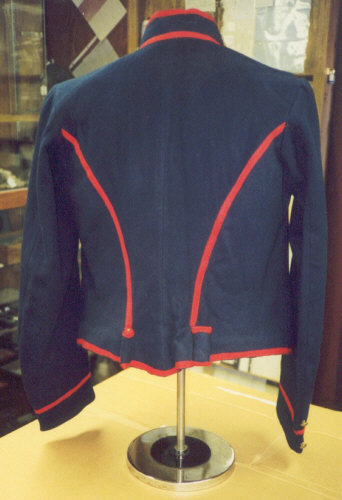 One
obvious feature that makes this garment unique among other
government-made mounted services jackets is the amount of
buttons down the front. The Federal Quartermaster
Regulations1 specified that the mounted
services jackets were to have a twelve button front. This
example from the St. Louis Depot features only eleven 3/4"
key hole corded buttons holes. The top buttonhole is
placed 3/4" from the top and the bottom buttonhole is set
1" from the bottom. The machine topstitching on the button
side of the jacket is 1" from the edge. One
obvious feature that makes this garment unique among other
government-made mounted services jackets is the amount of
buttons down the front. The Federal Quartermaster
Regulations1 specified that the mounted
services jackets were to have a twelve button front. This
example from the St. Louis Depot features only eleven 3/4"
key hole corded buttons holes. The top buttonhole is
placed 3/4" from the top and the bottom buttonhole is set
1" from the bottom. The machine topstitching on the button
side of the jacket is 1" from the edge.
The 3/8"
worsted wool scarlet tape is applied by sewing machine
throughout the entire garment with the exception of the
bolters, where it is sewn on by hand. This indicates that
the bolsters were set into the rear seam first, before the
tape was applied. The bolsters were set at the bottom of
the rear/side seams and were designed to 'bolster' the
weight of an artillery sable belt which carried the pistol
and sabre of a mounted soldier.
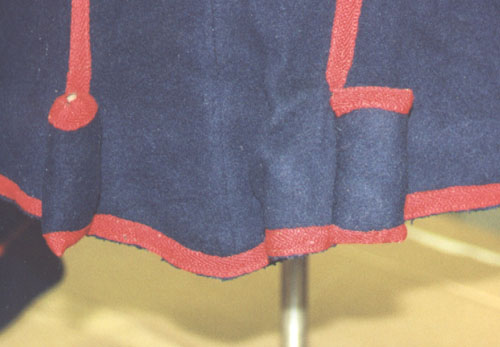 The
mounted services jackets are typically longer than most
other Civil War shell jackets as the belt needed ride
above the bolsters. The bolsters on this jacket are 5"
apart. 2 1/2" high, 1 1/8" wide. The
mounted services jackets are typically longer than most
other Civil War shell jackets as the belt needed ride
above the bolsters. The bolsters on this jacket are 5"
apart. 2 1/2" high, 1 1/8" wide.
While the
trim on the bolsters is applied by hand, the trim on the
back/side seam is applied by machine, since there is no
stitching on the inside of the lining, this must have been
done prior to the lining being set into the garment.
The overall
body measurements are 21" down the center back seam, 19
3/4" down the front and 11 1/2" down the side seam.
The
inspector stamp on the inside of the garment is marked
"GOV'T MANUFACTURE/JNO. SKERRITT, INSP'R/ST. LOUIS
MO." The Inspector stamp is 1" high by 2 1/2"
wide. John Skerritt worked in St. Louis at the Fourth
Street Hall (also known as Hall #4) from January 8, 1863
into June 1865 The garment is marked with two other
stamps, one is a size stamp is marked "2"
in red ink, this is most likely the size the garment was
cut to. Although marked size 2, few of the sizes of the
garment match those called for by the Federal
Quartermaster Regulations 2.
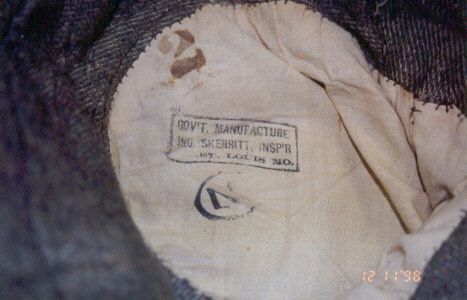 The
second "2" is likely the inspector's
confirmation of the size. For the Schuylkill Arsenal that
was the purpose of the dots. The dot stamp indicated the
size to the cutter/issuer of the kit to the seamstress,
and the numeral stamp indicated the size inspected and for
later reference. The
second "2" is likely the inspector's
confirmation of the size. For the Schuylkill Arsenal that
was the purpose of the dots. The dot stamp indicated the
size to the cutter/issuer of the kit to the seamstress,
and the numeral stamp indicated the size inspected and for
later reference.
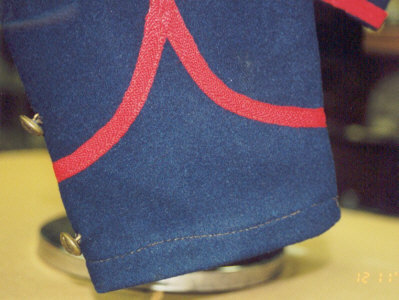 Unlike
other arsenal produced mounted services jackets, this
jacket had a non-functional cuff, instead of the
traditional two-button functional cuff. The jacket has a
two-piece sleeve and the cuff is topstitched 1/2" from
bottom. The chevron pattern trim is 2" high in the rear
and curves up to 4 1/2" in front. Button placement from
bottom of the cuff is 1 1/4" and 3 1/2". Width at the
elbow of the sleeve is 7 3/4" and the width at the cuff is
5 3/8" The sleeve lining is made from a thin off white
cotton material. Unlike
other arsenal produced mounted services jackets, this
jacket had a non-functional cuff, instead of the
traditional two-button functional cuff. The jacket has a
two-piece sleeve and the cuff is topstitched 1/2" from
bottom. The chevron pattern trim is 2" high in the rear
and curves up to 4 1/2" in front. Button placement from
bottom of the cuff is 1 1/4" and 3 1/2". Width at the
elbow of the sleeve is 7 3/4" and the width at the cuff is
5 3/8" The sleeve lining is made from a thin off white
cotton material.

The body
lining is woven out of a jean cloth with a brownish wool
yarn and off white cotton. Three rows of quilting are
machine stitched in a circular pattern about 2" to 3"
apart. The quilting covers the front and side panels. The
inside pocket is also made out of the same thin cotton
that the sleeves were cut from The pocket was in a kidney
shape about 13 1/2" high, 6" deep at bottom, 1 1/4" on
top. The pocket opening is about 5" and is double rolled
and hand topstitched. As the quilting skirts around the
pocket, it is safe to assume that the quilting was done
after the pocket was set. On most artillery jackets the
pocket was usually set after the quilting.
It is
interesting to note that some of the features which make
this jacket unique among government-made garments, can
also be evidenced on contract-made jackets. A letter
published in the Military Collector and Historian
Journal reveals that a contract made cavalry mounted
services jacket in a private collection also featured an
eleven button front, non-functional cuff, two-single rows
of tape on the collar and a low collar.3 This
jacket was made by Joseph Lee in New York.4
|
It is
doubtful that the mounted soldier noticed these slight
variations, other than the fact that the collar on
some jackets offered a bit more comfort than others.
However, the St. Louis Depot jacket allows the
collector and researcher of mounted services jacket to
study how the same set of regulations could be
interpreted differently within the government
quartermaster system. |
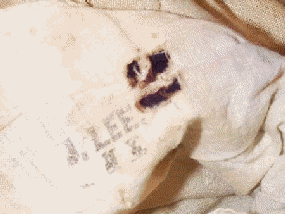 (Note:
This image is not from the St. Louis Depot Jacket,
but from another mounted services jacket made by
Joseph Lee from New York. Lee made mounted jackets
with similar features as the St. Louis jacket.) (Note:
This image is not from the St. Louis Depot Jacket,
but from another mounted services jacket made by
Joseph Lee from New York. Lee made mounted jackets
with similar features as the St. Louis jacket.) |
|
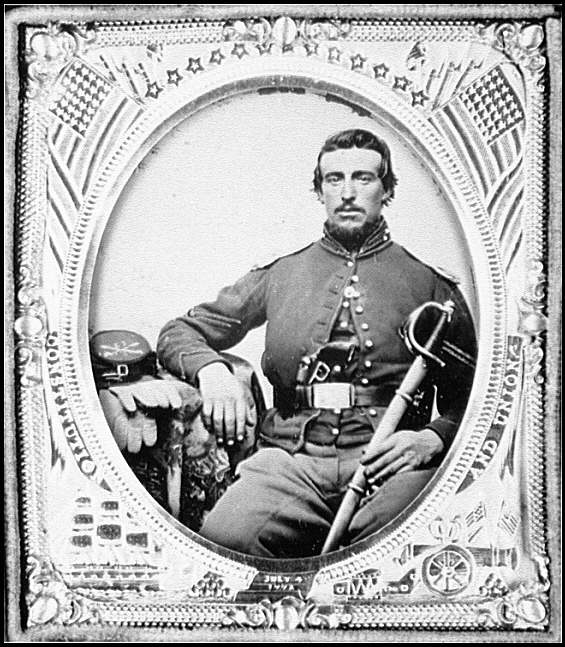
Corp.
Nailer, 13th Pennsylvania Cavalry, wearing a jacket
that has similar features to the St. Louis Depot
Jacket. |

An unidentified
Cavalry Trooper, also
wearing a St. Louis Depot 'style' Jacket. |
Thanks:
I'd like to thank the Fred Gaede for his info on
the St. Louis Depot, Inspectors John Skerritt, Contractor
Joseph Lee (Lea), and the US Quartermaster Regulations on
Mounted Services Jackets; and the Farnsworth House for
allowing me to document this garment.
Further Reading:
Tibbals, Richard K., Military Collector and Historian,
A variant Government-Made Artillery Jacket, Vol.
XXXIV, (Spring 1982), pp33-34, Washington D.C.
End
notes:
1. Jacket for light artillery or cavalry: 1 1/4 yards of
6-4 dark blue cloth; 1 yard of 7/8 lining; 1 yard of 4-4
unbleached muslin; 3/4 of a yard of 24 inch canvas; 1
sheet of black cotton wadding; I inch of brown holland; 20
vest buttons; 1 hook and eye, black; 6 1/4 yards of 3/8
worsted lace; 7 skeins of dark blue linen thread, No. 40.
For musicians, add 5 yards of lace, and 2 skeins of
thread.
2. Jackets
for Cavalry and Light Artillery-Sizes (All measurements in
inches)
|
Measurement |
Size #1 |
Size #2 |
Size #3 |
Size #4 |
|
Length of
Waist |
18 |
18 1/4 |
18 1/2 |
18 3/4 |
|
Length of
Coat |
34 1/2 |
35 |
35 1/4 |
35 1/2 |
|
Length of
Sleeve |
32 |
33 |
34 |
35 |
|
Length of
Collar |
8 |
9 |
9 1/2 |
10 |
|
Width of
Breast |
36 |
38 |
40 |
42 |
|
Width of
Waist |
32 |
34 |
36 |
38 |
|
Width of
Skirt |
32 |
33 1/2 |
35 |
36 |
|
Width of
Collar |
2 |
2 |
2 1/4 |
2 1/4 |
|
Width of
Sleeve |
5 1/2 |
6 |
6 1/5 |
6 1/2 |
3. Wheeler,
George T., Military Collector and Historian,
Question and Answer, Vol. XXXIV, (Winter 1982), p188,
Washington D.C.
4.This is
an e-mail from Fred Gaede date 5/21/01: Although Lee
was a contractor from October 1861 to the end of 1863,**
He didn't make too many uniform jackets. ( There are a
number of contracts for a Joseph Lea, also of NY City.)
For mounted services jackets in general he was paid for
"making and trimming" in Nov 1861, and between July and
Sept 1862. These were of Gov't supplied material and trim,
open-ended contracts so no numbers given. He delivered
5,000 artillery uniform jackets to the NY Depot in
November 1863, and 7,--- September 1863 10,000 November
1863 and 5,000 December 1863, all to NY Depot. One
contracts for Cavalry Musicians jackets, 2,000 to NY
February 1863.
**Interestingly, "Lea" only had contracts
in this listing for 1864 and 1865, so I'll bet they are
the same guy! Lea had one contract in March 1864 for cav
jackets, 10,000 to Cincinnati |



